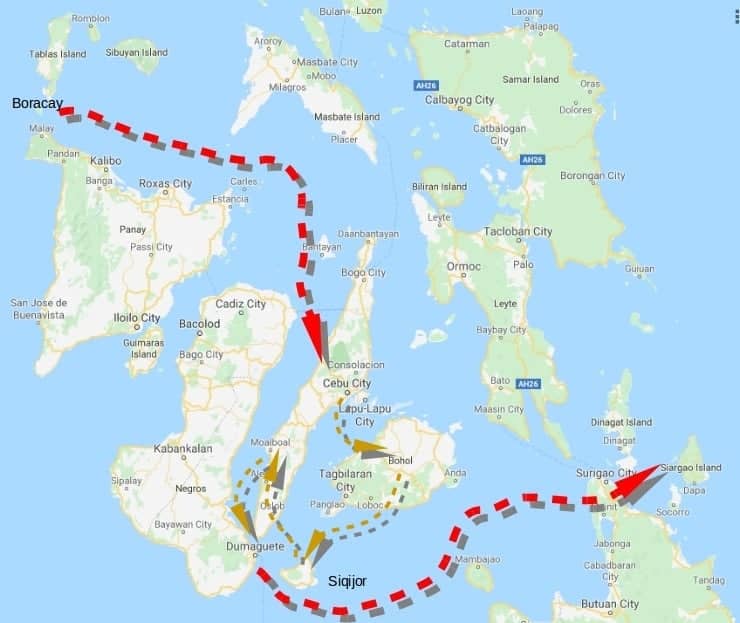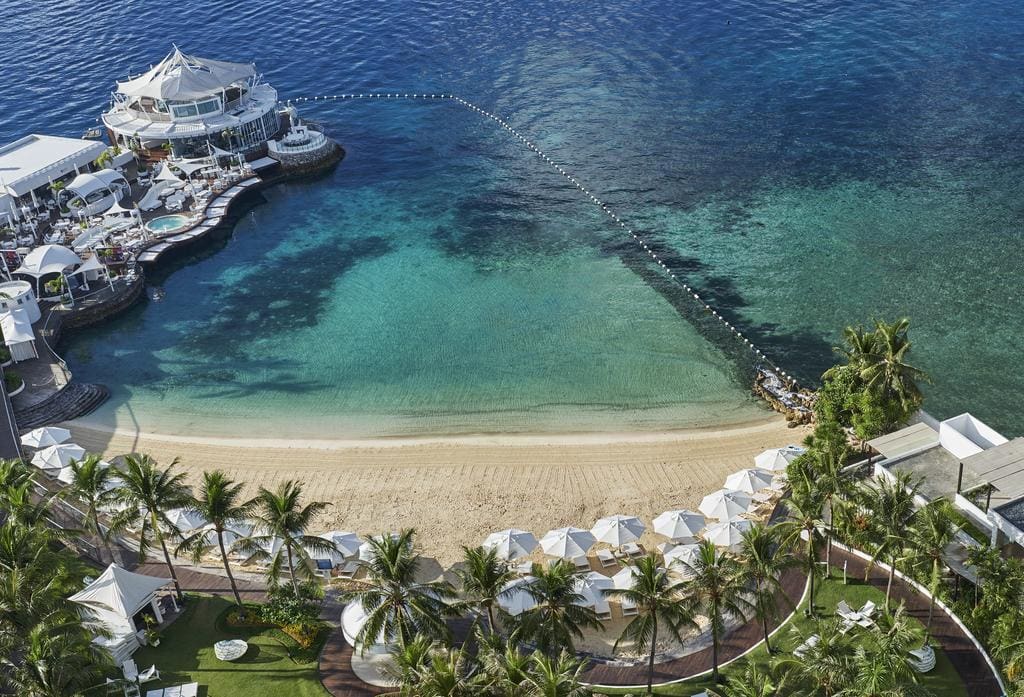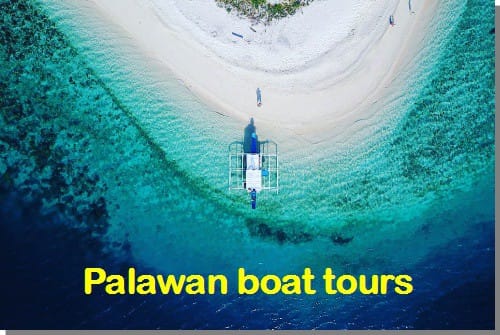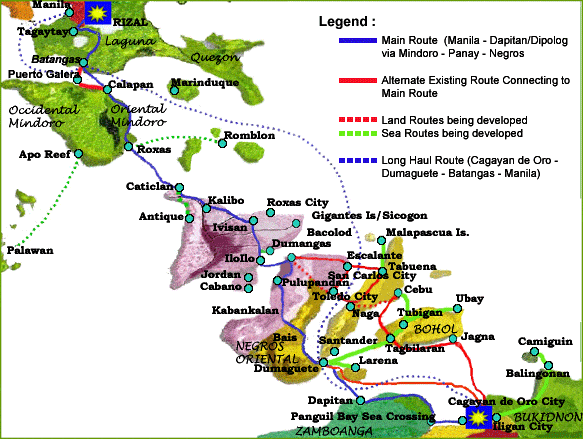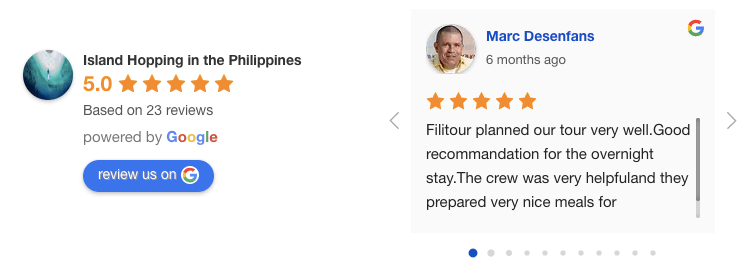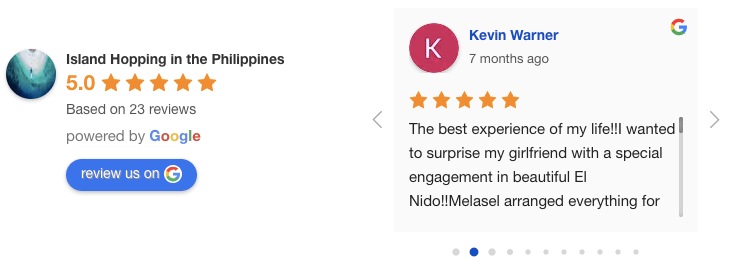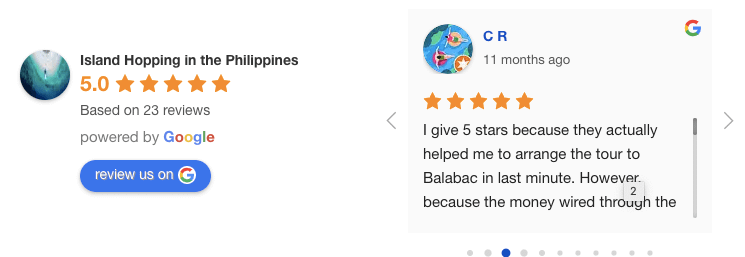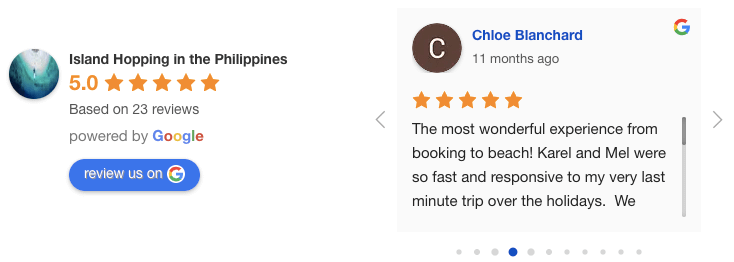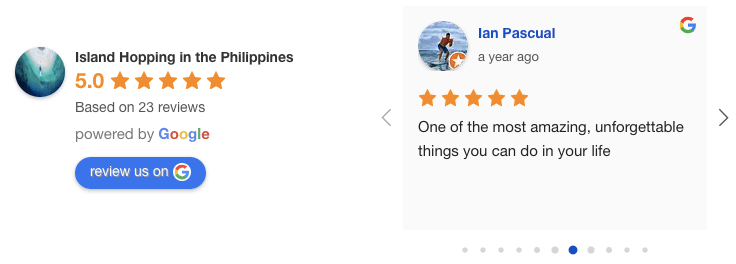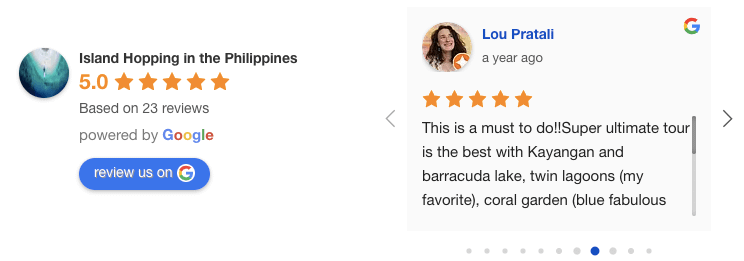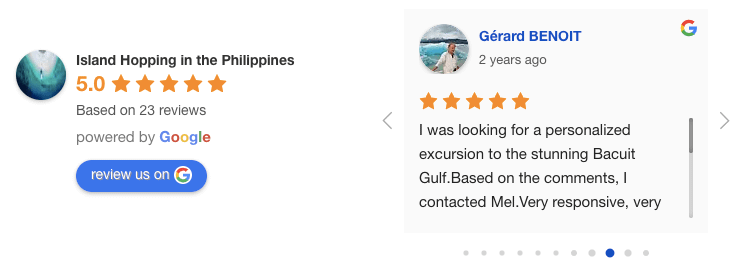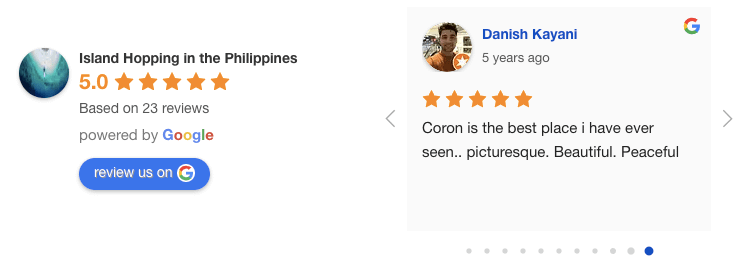Visayas Travel Info
Check out detailed travel, historical and cultural information on Visayas, the central region of the Philippines. After Palawan, especially the remote region between the popular tourist towns of El Nido and Coron, Visayas is considered the second most popular destination to visit in the Philippines.
Most popular sites to visit in Visayas, Philippines
The Visayas region of the Philippines is a cluster of islands that offer diverse attractions, from beautiful beaches to historical sites. Here are some popular destinations within the Visayas and the reasons why they’re popular:
Beaches and Natural Wonders
- Boracay Island – Known for its powdery white sand beaches and vibrant nightlife, Boracay is one of the most popular beach destinations in the Philippines.
- Panglao Island, Bohol – Famous for Alona Beach and its diving spots, Panglao is a quieter alternative to Boracay but offers its own charm and range of activities.
- Siquijor Island – Often associated with mysticism, this island is a peaceful spot with untouched beaches and forests. It’s becoming increasingly popular for those looking to escape the commercialism of other destinations.
- Malapascua Island, Cebu – Known as a diving paradise, particularly for those interested in thresher shark diving.
- Apo Island, Negros Oriental – This is another diving hotspot, particularly famous for its coral reefs and rich marine life.
- Kawasan Falls, Cebu – A three-stage cascade of crystal-clear waterfalls, popular for canyoneering adventures.
- Kalanggaman Island, Leyte – Known for its long sandbar, it’s popular for picnics, snorkeling, and diving.
- Tumalog Falls, Oslob, Cebu – Famous for its unique “horsetail” waterfalls, and often visited along with Oslob’s whale shark watching spots.
- Bantayan Island, Cebu – Known for its serene beaches, old churches, and laid-back lifestyle.
Historical and Cultural Sites
- Fort San Pedro, Cebu City – A military defense structure built by the Spanish in 1565.
- Magellan’s Cross, Cebu City – A Christian cross planted by Portuguese and Spanish explorers as ordered by Ferdinand Magellan.
- The Ruins, Negros Occidental – Also known as the Taj Mahal of Negros, this is the remains of the mansion of a sugar baron.
- Santo Niño Church, Cebu City – Founded in the 16th century, it is the oldest Roman Catholic church in the country.
- Molo Church, Iloilo – Known for its beautiful Gothic architecture and its history of being built by women during the Spanish colonial period.
Adventure and Wildlife
- Oslob, Cebu – Known for whale shark watching, but this activity is somewhat controversial due to its environmental impact.
- Chocolate Hills, Bohol – These are 1,268 perfectly cone-shaped hills of about the same size, spread over an area of 50 square kilometers.
- Loboc River, Bohol – Known for its river cruises and floating restaurants, it’s a peaceful way to see the countryside.
- Osmena Peak, Cebu – The highest point in Cebu, it offers panoramic views of the island.
- Canlaon Volcano, Negros – One of the most active volcanoes in the Philippines, popular among trekkers and mountaineers.
Each place has its unique charm and attractions, catering to various interests from beach lounging and diving to cultural exploration and adventure sports.
Intro
The Visayas Islands are composed of seven large and several hundred smaller islands in the center of the Philippines. Most of the islands are characterised by high mountains, one of them famous for its round hills. It has its own languages, as the country has hundreds of local dialects, and the region hosts the country’s sixth largest city, Cebu City.
Cebu City is the country’s oldest settlement and one of its most historic, retaining much of the flavour of its 300 year colonial rule by the Spanish.
The Visayas also has many interesting tourist areas to visit and natural wonders, as you can check out through the list of links above and below. For your average one or two week vacation schedule, we recommend the route shown at the top of this page, or you can check out some of our other route suggestions.
During your choice of route through the country, if you make it over to the Palawan area, that is our favourite and where we organise private custom boat tours.
Experience the thrill of island hopping in the Philippines
Below the following links you will find more information about the Visayas.
Posts by category
- Category: boat tours trips
- Kimud Shoal Dive Guide — Malapascua, Cebu (Visayas, Philippines)
- Capitancillo Island (Cebu) — A Hidden Marine Sanctuary
- Sumilon Island Travel Guide — Southern Cebu’s Hidden Gem
- Pungtud Island Travel & Visit Guide — Bohol’s “Virgin Island”
- Pescador Island Travel & Dive Guide — Visayas, Philippines
- Oslob Travel Guide — Whale Sharks, History & Island Escapes
- Moalboal, Cebu Travel Guide (Visayas, Philippines) — Beaches, Sardine Run & Pescador Island
- Cabilao Island Travel Guide — Dive, Relax & Explore
- Apo Island Guide
- Pamilacan Island: Your Ultimate Travel Guide to Visayas’ Hidden Gem
- Discover Gato Island: The Hidden Gem of the Philippines
- Discover Limasawa: A Hidden Gem in Southern Leyte, Philippines
- Malapascua Island: An Unspoiled Gem in the Visayas
- Category: Bohol
- Category: Cebu
- Explore Monad Shoal: The Ultimate Diver’s Paradise in the Philippines
- Unveiling Kalanggaman Island: The Pristine Paradise of the Philippines
- Discover Sogod Bay: The Jewel of Southern Leyte, Philippines
- Explore Napantao Marine Sanctuary: A Diver’s Paradise in Southern Leyte, Philippines
- Discovering Padre Burgos: The Adventure Hub of Southern Leyte, Philippines
- Exploring Anda: The Hidden Paradise of Bohol, Philippines
- Unveiling Panaon Island: The Crown Jewel of Southern Leyte, Philippines
- Cebu area scuba diving and snorkeling tours and tour packages
- Exploring the Magic of Mactan: Island Hopping Boat Tours Near Cebu
- CEBU CITY: Revealing Paradise in the Queen City of the South
- Category: Explore
- Category: FAQ
- Diving Ticao Pass (Masbate, Philippines): Who Operates There, How to Go, Where to Stay
- Cebu, Mt. Kanlaon Volcano & Bohol Tour Package
- Manta Ray Snorkeling in Cebu – What are the chances of seeing them?
- Limasawa & Panaon Island Tours from Padre Burgos – FAQ & Travel Guide
- Carbin Reef and Suyac Island Boat Tour from Sagay – Private Group FAQ
- Category: Guimaras
- Beer drinker’s detox and weight loss wellness retreat
- Construction company – build a house on Guimaras
- Road trip Guimaras
- Harnessing the Winds of Change: An Overview of Wind Farms on Guimaras Island
- La Puerta Al Paraizo Beach Resort, Guimaras
- Alubihod boat tour
- Taklong Marine Reserve: A Biodiverse Paradise in Guimaras
- Top Things To Do and Places to Visit in Guimaras
- Island Hopping Travel Boat Tour Packages to Guimaras Island
- Category: Negros
- Dumaguete: The City of Gentle People
- Sipalay: An Underrated Marvel in Negros
- Travel Tour Packages to Campuestohan Highland Resort Theme/Water Park
- Travel Tour Packages to Suyac Island Mangrove Eco-park
- Travel Tour Packages to The Ruins, Taj Mahal of Negros
- Travel Tour Packages to Carbin Reef, Sagay Marine Reserve
- Travel Tour Packages to Lakawon Island Resort and Spa
- Travel Tour Packages to Kanlaon Natural Park
- Travel Tour Packages to Mambukal Resort Waterfalls
- Category: Our places
- Category: Panay
- Where to Go in Romblon: A Humble Island with the Best-Kept Secrets
- Motorbike Tour of Boracay
- Aira Boracay Hotel
- Boracay Restaurant Guide: 15 Spots to Fill Your Belly
- Panay Island
- Best Activities to Enjoy While in Boracay
- A Guide to Boracay Island
- Seco Island, a Pristine Sandbar Haven in Antique
- Evelyn’s Beach Resort, Panay
- Jawili Falls, Panay
- Dinagyang Festival 2019, meeting at Jeproks, Couchsurfing event
- Igpasungaw Waterfalls in Sebaste
- Travel Tour Packages to Hinulugan Waterfalls
- Carles Sicogon Gigantes boat tours
- Travel Tour Packages to Kataw Waterfalls
- Travel Tour Packages to Bulubadiangan Island
- Travel Tour Packages to Marbuena Island
- San Antonio de Padua Church
- Travel Tour Packages to Carles, Gigantes
- Iloilo City and Travel Tour Packages from
- Miagao Church
- Category: Siquijor
- Category: Tour Guides
- Category: Tour Packages
- Category: v
Or the same posts but organized by topic or type:
Tags
Important links:
- suggested tours and routes of the country. Design your own itinerary!
- breakdown by region and categories
- let us organise for you a custom boat tour in Palawan
Or if you have any questions…
Information about traveling to Visayas

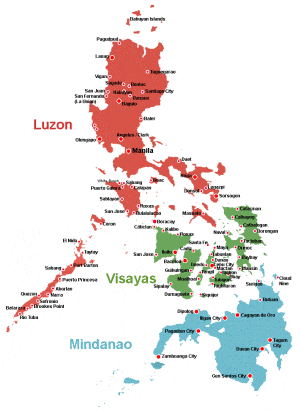
History of Visayas
The earliest settlers in the Visayan region were Austronesian Animist tribes dating back to around 30,000 BC. Austronesians are also the ancestors of Indonesians, Malaysians, Micronesians, Polynesians, New Zealanders, Hawaiians and countries in East Africa, and are said to have originated from mainland China, branching out through Taiwan (flow of migration shown in map below).
As explained below, their religion was animist, but by the 12th century, the Hindu-Buddhist empire of Srivijaya in Sumatra (present day Indonesia) had begun to collapse, escaping to the island of Panay and surrounding areas.
 The word Visayas came from the 7th century empire of Srivajay, in Sumatra, whereby “sri” in Sanskrit means “fortunate”, “prosperous”, or “happy”, while vijaya means “victorious”.
The word Visayas came from the 7th century empire of Srivajay, in Sumatra, whereby “sri” in Sanskrit means “fortunate”, “prosperous”, or “happy”, while vijaya means “victorious”.
The early inhabitants of this region were Austronesian, who came to the area between six and thirty thousand years ago.

It was during this time that the Visayans began to be somewhat famous among inhabitants living along the southeastern coast of China. Although there is evidence that trade took place among these different people, the Visayans were more remembered for their seasonal pillaging rampages.
Having a new mix of people from Sumatra, Indonesia, the Visayans were able to communicate with the Malaysians and Indonesians, and hence Enrique of Malacca when the Portuguese explorer Ferdinand Magellan arrived in 1521.
Tattoos
In northern Luzon the locals had a system of commemorating victories of head hunters, tattooing their bodies like present day generals do with their coloured trinkets pinned to their suits.
In the Visayas, they may have not lopped off the heads of their victims so frequently, but the adornment was the same.

The Europeans described the Sugbu Visayans as heavily-tattooed “not because this is natural to them, although they are well built, of pleasing countenance, and white; but because they adorn their bodies with figures from head to foot, when they are young and have sufficient strength and energy to suffer the torment of the tattooing; and formerly they tattooed themselves when they had performed some act of valor.”
One Spaniard described the Visayans as “a race of skillful navigators who were eager for pillaging raids.” Describing them as follows:
The Visayas live in a remote land in the eastern sea, where the hills are flat and deserted and the fields are little tilled. There is not much planting. The climate is scorching hot. The natives are fond of pillaging. The males and the females both tie their hair in a topknot, tattoo their bodies here and there with ink, and wrap their heads with a piece of red silk to which a piece of yellow cloth is tied to make a tail. Their country has no chief, and the land produces nothing. At times they prepare dry provisions, row in a small boat, go to other barbarians, lie in ambush in wild mountains and remote valleys where no man lives, capture fish-catchers and fuel-collectors whom they happen to meet, and bring home and sell the prisoners to other countries, in which transactions they get two ounces of gold apiece. Men of that country make their living by this custom from generation to generation, for which reason the people of the eastern sea, upon hearing the name of Visaya, are all terrified and flee.

And it was a custom back then to adorn one’s body with the spoils of war. After all, with a constant temperature of 33C all year round, why bother with clothes? Tattoos became the clothes paint, but also a symbol of stature.
Based on their animistic religion (explained below), these tattoos were both a representation of success in battle (or in the case of women, for beauty) and also for protection (Oraciones or sacred scripts and esoteric designs, similar to the Yantra Tattoo of Thailand). Most of the designs reflected beautiful imagery of nature. The ‘Labid’, for example, was an inch-wide vertical design resembling a snake or crocodiles’ scale pattern, zigzagging from one’s legs up to their waist. ‘Bangut’ was earmarked exclusively for the face of warriors and resembled the gaping jaw or a crocodile or eagle.

Tattoos had different meanings on different parts of the body, with chest tattoos reserved only for those who had partaken in a series of battles. The more battles they partook in, the more tattoos would be inscribed, until they began to cover their backs. Facial tattoos, however, were only reserved for the bravest of the warriors within a particular tribe. Those who endured the pain and earned the right to get tattoos right up their eyelids were considered like the Spartan elite.

Another purpose of the tattoos of these fierce warriors was to project intimidation and fear among their enemies as part of their psychological warfare during tribal raids. It also earned respect in the local community, also for the reason that it was very painful to undergo. Using a thorn from local Calamansi trees, this ancient art was accomplished in two ways: one by dipping the thorn into a charcoal paste which was then tapped into the skin; the second by cutting the skin to then rub charcoal powder into the subsequent wound. Or they would use an iron or brass point heated up in the fire beforehand. The ink was known as biro, made from the juice of the ripe fruit of the vine langi’ngi (Cayratia trifolia), and powdered charcoal or soot scraped from the bottom of pots and cooking cans.
 Obviously a painful process, the operation performed in installments (and based on battles). But even so, it would often cause a high fever and occasionally infection and death. During the healing period, if there was an infection which caused the designs to become muddied, they would call it mud (lusak).
Obviously a painful process, the operation performed in installments (and based on battles). But even so, it would often cause a high fever and occasionally infection and death. During the healing period, if there was an infection which caused the designs to become muddied, they would call it mud (lusak).
The markings often depicted snakes or lizards, but there are always those who wish to gain respect without the cost, tattooing themselves without the show of bravery. These men were considered fakes and cowards and were referred to as the halo lizard, which is large, black and yellow, looks like it is tattooed all over, but is a very shy and timid animal.
Besides the tattoo, during these times certain clothing also depicted a tribe member’s warrior status. For example, a red headdress, just like Johnny Depp in Pirates of the Caribbean, were worn by those who made at least one kill in battle. The fashion envy of the time was made of abaca fibers tie-dyed and polished to a silky shine. Only the valiant few were entitled to show such grandeur.
Who were these enemies, anyway?
Enemy might not be the proper term but rather victims of pillage and slaughter. Here is a Chinese account of a 12th century Visayan pirate attack on what is now the southern part of Taiwan:
 “Nearby is the country of P’i-she-yeh (Visayas). Their language is unintelligible, and they go naked and lead so primitive a life that is almost subhuman. Once during the Ch’un-lui era (1174-89), a chief of the country, at the head of several hundred of his men, suddenly came to Shui-ao, Wei-t-ou and other villages of Ch’uan-chou and wantonly committed slaughter and pillage.
“Nearby is the country of P’i-she-yeh (Visayas). Their language is unintelligible, and they go naked and lead so primitive a life that is almost subhuman. Once during the Ch’un-lui era (1174-89), a chief of the country, at the head of several hundred of his men, suddenly came to Shui-ao, Wei-t-ou and other villages of Ch’uan-chou and wantonly committed slaughter and pillage.
“They showed a passion for iron vessels, spoons and chopsticks. People would escape from their hands by shutting the door; then they would tear [these] off and take away the door knobs. When a spoon or a pair of chopsticks was thrown to them, they would stop to pick it up. When they saw an iron-clad cavalryman, they would rush forward to peel off his armor, showing no remorse even if their heads were lopped off left and right. In combat they employed javelins, to which was tied a rope more than a hundred feet long, for they valued the iron spearhead so highly that they could not let it be lost. They do not sail in a boat, but make a raft by tying bamboo canes together. When in danger they carry the raft on their shoulders down to the water and row away on it.”
Dangerous, but honest

As one trader commented:
When trading ships enter the anchorage, they stop in front of the official’s place, for that is the place for bartering of the country. After a ship has been boarded, the natives mix freely with the ship’s folk. The chiefs are in the habit of using white umbrellas, for which reason the traders offer them as gifts.
The custom of the trade is for the savage traders to assemble in crowds and carry the goods away with them in baskets; and, even if one cannot at first know them, and can but slowly distinguish the men who remove the goods, there will yet be no loss. The savage traders will, after this, carry these goods on to other islands for barter, and, as a rule, it takes them as much as eight or nine months till they return, when they repay the traders on shipboard with what they have obtained for the goods.
The products of the country consist of yellow wax, cotton, pearls, tortoise shell, medicinal betel nuts and yu-ta cloth; and the foreign traders barter for these porcelain, trade-gold; iron censers, lead, colored glass beads, and iron needles.
The Spaniards later marveled on their honesty when, even after furnishing them with ample alcohol, they would still be capable of weighing the gold scales exactly.
The Spanish are coming!

Alas, the dreamy days of pillage and walking around half naked can only last so long. The first conqueror (actually Portuguese, paid by the Spanish, like Columbus in North America) to arrive in 1521 was Ferdinand Magellan, his little army shocked at the brutality of the locals, as testified in the following. The conquistadors called the locals “Pintados”, meaning “painted ones”. They originally called the area “La Isla de Los Pintados” (Island of the Painted Ones), but later renamed it as Las Islas Filipinas, in honour of their King Philippe. The painted and brutal nature of the locals only convinced the colonialists that these “savages” needed saving and taming, but that it also represented a means for their own wealth.
The Pintados are a courageous and warlike race; they have continually waged war on both land and sea for pillage and booty, which they call ‘Mangubat’. This word means going to other lands in search of conquest; to go out to plunder, to raid or to fight.
The manner in which they set out on raids is as follows:
Lots are cast using the teeth of a crocodile or wild boar. During the ceremony, the men invoke their gods and their ancestors, and inquire of them as to the result of their impending wars and journeys. By knots or loops, made of cords, they foretell what will happen to them, and they resort to these practices for everything which they undertake.
The Indios along the coast are accustomed to setting out every year on plundering expeditions in the season of the bonanças, which takes place between the brisas and the vendabals. The Tinguianes set out after they have gathered their harvests, and since it is their custom to be enemies of those who are enemies to their friends, they do not lack opportunity to fight.

While on plundering expeditions, any enemy captured alive is not killed. If anyone kills a captive after his surrender, he has to pay for the victim with his own money, and if unable to do so, he is held as a slave. One such example is Prince Giolo, a tattooed tribal man purchased as a slave in Mindanao and who was shipped off as an exhibit to England to show the “living artwork of savages” (picture below left).
 Otherwise, any non-human booty plundered would automatically become the property of the tribal chief, minus a small portion allocated to the oarsmen of the plundering crew.
Otherwise, any non-human booty plundered would automatically become the property of the tribal chief, minus a small portion allocated to the oarsmen of the plundering crew.
Others have written:
The principal clothing of the Cebuanos and all the Visayans is the tattooing of which we have already spoken, with which a naked man appears to be dressed in a kind of handsome armor engraved with very fine work, a dress so esteemed by them they take it for their proudest attire, covering their bodies neither more nor less than a Christ crucified, so that although for solemn occasions they have the marlotas (a smock) we mentioned, their dress at home and in the barrio is their tattoos and a bahag, as they call that cloth they wrap around their waist, which is the sort the ancient actors and gladiators used in Rome for decency’s sake.
The first island conquered and colonized by the Spaniards was Cebu, and marked the first circumnavigation of the planet in the 1520s. Two weeks later, on Good Friday, a blood compact had been made between Magella and an emissary of the King from an island off the coast of souther Leyte, to seal a political pact between Spain and the Philippines. This was followed by the first Mass in the Philippines two days later, on Easter Sunday. Unfortunately, Magellan’s exploits and world travels came to an abrupt end when his life was taken by a warrior-ruler named Lapu-Lapu on Mactan Island in Cebu Province.
 Island of Samar
Island of Samar
The Spanish Crown was inspired by these exploits and sent several other expeditions, naming the islands Las Yslas Felipinas, in honour of their King Philippe, which later applied to the entire country. There were several rebellions, lasting until 1650, when a government expedition composed of Spaniards and Filipino mercenaries captured the leaders of the movement in the mountains of Samar, after which the revolt was easily suppressed. Actually, there is an interesting spin that the Philippines was technically colonized by the Mexicans!
American colonization of the Visayas and Philippines

Speaking of plundering and pillaging, and the Mexicans, the American battleship Main was “mysteriously” sunk in a Cuban harbour in 1898. There was an uproar in the US, which eventually forced the president at the time to reluctantly declare war on Spain. Spain lost, and in the spoils, the Philippines was handed over to the US. This led to the Philippine-American war, until the Philippines finally attained independence in 1946.
The fierce fighters in Visayas were at it again, this time completely slaughtering the US 9th Infantry in the 1901 Balangiga Massacre. The US described this as the greatest defeat since the Battle of the Little Bighorn in 1876 (Custer’s last stand in the US’s domination of the First Nation’s People in North America). The locals hacked away with their machetes against the rifles and guns of the mighty US army, but in future battles eventually lost, the US stealing three church bells as war trophies. At the time of writing this article, in August of 2018, they are in negotiations to be returned. Probably because the US needs more bases in the region for its power struggle against China.

During World War II the region then became another major battleground, this time between the US and Japan at the very same gateway that the Spanish conquistadores had taken to penetrate the East four centuries earlier, in Leyte. The island was the center of Japanese air and military bases covering the entire country and was considered almost impregnable. General Douglas MacArthur later wrote that he thought it would be rather risky, but decided to take the gamble, undertaking one of the bloodies battles against the Japanese in October of 1944. Upon victory, Leyte became the seat of the Commonwealth until 1945 and paved the way for the country’s eventual independence.
Visayan folklore
Prior to the arrival of Catholicism, precolonial Visayans adhered to a complex Hindu-Buddhist and animist system, where spirits in nature were believed to govern all existing life.
Visayan Creation Myth
Thousands of years ago, the world was without land, sun, moon or stars, but there was only a great sea, with the sky stretching above. The water was ruled by the goddess Maguayan, with the sky ruled by the great god Kaptan.

Maguayan had a daughter named Lidagat, the sea, while Kaptain had a son named Lihangin, which was the wind. The gods agreed that their children should marry, the sea and wind in turn giving birth to a daughter and three sons.
Likalibutan, one of the sons, had a body of rock and was strong and brave. Liadlao was made from gold and was always happy. Libulan was made from copper but was weak and timid, while the beautiful daughter, Lisuga, was made from pure silver and had a sweet and gentle nature.
The couple was very happy with their children, but eventually Lihangin died and surrendered control of the winds to his eldest son, Likalibutan. The mother soon passed away as well, leaving the children alone. So their grandparents, Kaptan and Maguayan, accepted responsibility for the children and protected them from harm.

But after some time, Likalibutan became proud with his power over the wind and decided he wanted more, approaching his brothers to join him in a battle against Kaptan in the sky above. At first they declined, but when Likalibutan became angry, Liadlao did not wish to offend him, so he agreed. Together they then convinced the shy Libulan to join them.
They prepared for their attack and rushed at the sky, but were not able to break down the steel gates which blocked the entrance. Likalibutan unleashed a tempest of the strongest winds and managed to blow the bars apart. The brothers raced through the opening, but were confronted with a very angry Kaptan, who appeared so fierce that the three flew in terror. However, Kaptan, angered by what they had done to the gates, fired three bolts of lightning at them.

The first lightning bolt struck the copper Libulan and melted him into a ball. The second bolt struck the golden Liadlao, melting him as well. The third struck Likalibutan, breaking his rocky body into many pieces as they fell into the sea. But Likalibutan was so huge that parts of his body protruded from above the surface of the water, becoming land.
Meanwhile, the gentle Lisuga wondered where her brothers were and began to search for them. She first went to the sky, but as she approached the entrance and the broken gates, Kaptan, still enraged with fury, struck her with lightning as well, breaking her silver body into thousands of pieces.
Still in rage, Kaptan came down from the sky and tore the sea apart. He called out to Maguayan and blamed her of the attack. She soon appeared but professed that she was not aware of this plan, saying that she had been asleep deep in the sea. It took some time to convince Kaptan of her sincerity, after which they wept in remorse for the loss of their grandchildren, in particular the beautiful and gentle Lisuga. Unfortunately, in spite of all their powers, they were not able to bring them back to life, so instead they gave each of their bodies a beautiful light that shines forever.

The golden Liadlao therefore became the sun, the copper Libulan the moon, while the fragmented pieces of Lisuga’s silver body became the stars throughout the sky. What concerns Likalibutan, because of his evil ways, he was not awarded any light but was sentenced to support a new race of people. Kaptan then gave Maguayan a seed, which she planted on one of the islands.
A new race is born
This gave birth to a new bamboo tree, out of whose hollow branch came forth a man and a woman, the parents of the human race.

The youngest of their children was very inventive and designed a trap to catch fish. Very soon he had already caught himself a very large shark. When he pulled it to shore, it seemed so large and fierce that he mistook it for a god, at once ordering his people to worship it. The people gathered, sang and prayed to the shark, when the sky and sea opened and the gods demanded that Pandaguan return the shark back to the sea and not to worship anyone else but them.
The people were struck with fear, but not Pandaguan, who brazenly responded that the shark was as big as the gods, and because he was able to gain control of it, he could do the same to the gods. Kaptan, on hearing this, struck Pandaguan with a small lightning bolt, since Kaptan did not desire to end his life but only to give him a lesson. The two gods then decided to punish the people by carrying them to different parts of the world to scatter them. These people then had more children and the entire world became populated. Pandaguan survived the ordeal, recovering for thirty days while lying on the ground. But the lightning bolt had left a dark scar on his body, his offspring becoming the dark-skinned tribe of the Negritos.

Original folklore from other parts of the country can be found at: https://www.aswangproject.com/visayan-origin-myth/
Languages spoken in Visayas
 Most Visayans speak one or more of the local languages, Cebuano spoken the most (making up about one fifth of the entire Filipino population as a mother tongue), followed closely by Hiligaynon (Ilonggo) and Waray-Waray. As evident from the migration history explained above, all three languages are closely related to Malayo-Polynesian. Waray is widely spoken in Eastern Visayas, from Samar to the northern part of Leyte and parts of Biliran; Cebuano is widely spoken in Central Visayas, including Southern Leyte, parts of Biliran and the eastern part of Negros; while Hiligaynon is widely spoken in Panay, Guimaras and the western part of Negros.
Most Visayans speak one or more of the local languages, Cebuano spoken the most (making up about one fifth of the entire Filipino population as a mother tongue), followed closely by Hiligaynon (Ilonggo) and Waray-Waray. As evident from the migration history explained above, all three languages are closely related to Malayo-Polynesian. Waray is widely spoken in Eastern Visayas, from Samar to the northern part of Leyte and parts of Biliran; Cebuano is widely spoken in Central Visayas, including Southern Leyte, parts of Biliran and the eastern part of Negros; while Hiligaynon is widely spoken in Panay, Guimaras and the western part of Negros.
The Visayas region makes up the largest geographical grouping in the country, its population amounting to 33 million in 2010.
Languages spoken in the region:
| Language | Speakers | Date/source |
| Aklanon | 394,545 | 1990 census |
| Ati | 1,500 | 1980 SIL |
| Bantoanon(Asi) | 200,000 | 2002 SIL |
| Butuanon | 34,547 | 1990 census |
| Caluyanon | 30,000 | 1994 SIL |
| Capiznon | 638,653 | 2000 |
| Cebuano 1 | 20,043,502 | 1995 census |
| Cuyonon | 123,384 | 1990 census |
| Hiligaynon 1 | 7,000,000 | 1995 |
| Inonhan | 85,829 | 2000 WCD |
| Kinaray-a | 377,529 | 1994 SIL |
| Malaynon | 8,500 | 1973 SIL |
| Masbatenyo | 350,000 | 2002 SIL |
| Porohanon | 23,000 | |
| Ratagnon | 2 | 2000 Wurm |
| Romblomanon | 200,000 | 1987 SIL |
| Sorsogon, Masbate | 85,000 | 1975 census |
| Sorsogon, Waray | 185,000 | 1975 census |
| Surigaonon | 344,974 | 1990 census |
| Tausug 2 | 2,175,000 | 2012 SIL |
| Waray-Waray | 2,437,688 | 1990 census |
| Total | 33,463,654 |
1 Philippines only.
2 Philippines only; 1,022,000 worldwide.
How to get to Visayas

There are nine major island groups – Cebu, Bohol, Siquijor, Negros, Guimaras, Panay, Romblon, Samar, and Leyte – but it’s the hundreds in between that make this part of the archipelago so irresistible. Of the smaller islands, some are famous for their beach life (especially Boracay, off the northern tip of Panay), some for their fiestas, and some for their folklore.
The region’s main air hub is Mactan-Cebu International Airport. It has domestic flights to most airports in the Philippines, international flights to many in the Asia/Pacific region, and a few to places beyond that.
Air Asia and/or Philippine Airlines fly from Manila to many major cities in the Visayas: Cebu, Tagbilaran, Tacloban, Kalibo, Iloilo, Bacolod and Dumaguete.
The port in Cebu City is the main hub for sea travel. It has boats to many destinations in the Visayas, several in Mindanao, and Manila. Other port cities such as Dumaguete and Iloilo also have many ferries.
Within the Visayas, the ferry network is so extensive it doesn’t really matter if you can’t get a flight (below map is just an indication).
More on Visayas Tattoos and elsewhere in the Philippines
Like the Polynesians and their ancestors the Austronesians, Filipinos have a rich history and culture of tattooing. It was a part of society and if you did not participate, you were perceived as an outcast and would not be received by the ancestors into the afterlife. However, there were certain people among them who had both feminine and masculine qualities and considered to have a different gender altogether. These Asogs were respected and considered to be closer to the spirits and ancestors, were often spiritual leaders, and hence excused for being “unmarked”, or of natural, unpainted colour.
The Spanish colonialists noted that the Visayans would raise their hands towards the sun whenever asking for their deity’s help. On the other hand, snakes were associated with the underworld, one large serpent coiled below the five pillars that support the world. The facial tattoos in the form of a crocodile’s jaw links the warrior to the Tagalog deity Buwaya, who transfers the souls of the dead to their resting place. These body designs made by the ancestors are considered as windows into the spirituality of the Filipino people prior to their subjugation by the colonizers.

The Pintados-Kasadyaan Festival is a month-long festival in Tacloban, Leyte, which features people painting their bodies like the Pintados before them.
Headhunters in the north (northern Luzon)
There is another group of people in the Philippines who associate body paint as a man’s journey from a legitimate head hunter to a fearsome warrior. With their first kill, he acquires a “gulot”, a tattoo in a banded stripe pattern. His second kill results in another tattoo on his hands. The more kills he achieves, the more intricate the tattoo design on him, until he works up to his cheeks, which is considered a warrior of the highest caliber. The headhunters believed that the tattoos gave them spiritual powers and magical qualities empowering them with strength and providing protection. The tattoos also served as marking their social status within the tribe.
Women also tattooed, for beauty, fertility and as a means of clothing.
The last tattooist
 This traditional form of tattooing, called Mambabatok, has no more great demand because there are no longer any headhunters in the deep jungles of northern Luzon, but there is one remaining tattoo artist, or Magbabatuk, in the Cordillera region, Buscalan, Tinglayan, who offers the service to tourists and fans. Her name is Whang-Od Oggay (Fang-Od) belonging to the Butbut Kalinga ethnic group. She learned the skill from her father at the age of 15, has remained unmarried and childless, is now over a hundred years old and teaching the art to her niece in the hopes of preserving the tradition. In June of 2018 she was awarded the Dangal ng Haraya Award for Intangible Cultural Heritage by the National Commission for Culture and the Arts.
This traditional form of tattooing, called Mambabatok, has no more great demand because there are no longer any headhunters in the deep jungles of northern Luzon, but there is one remaining tattoo artist, or Magbabatuk, in the Cordillera region, Buscalan, Tinglayan, who offers the service to tourists and fans. Her name is Whang-Od Oggay (Fang-Od) belonging to the Butbut Kalinga ethnic group. She learned the skill from her father at the age of 15, has remained unmarried and childless, is now over a hundred years old and teaching the art to her niece in the hopes of preserving the tradition. In June of 2018 she was awarded the Dangal ng Haraya Award for Intangible Cultural Heritage by the National Commission for Culture and the Arts.
If you are interested in checking her out, looks like a bit of a journey as explained by this and this blogger. Or you could try out her facebook page.
Otherwise, if you are ever passing through the Palawan area, let us organise a custom boat tour for you, off the beaten path and linking the two tourist hot spots of El Nido and Coron:
Experience the thrill of island hopping in the Philippines
Interesting facts and history about the Philippines | Palawan
Explore the Philippines
Our reviews:

Home »
We are a family operation managing private custom boat tours in the beautiful Palawan area, and are happy to help travelers with their plans through the country, having traveled a lot of it ourselves and planning to visit it all.
